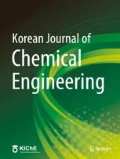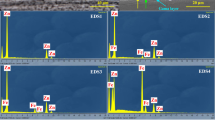Abstract
This work was carried out to study the inhibition mechanism of volatile corrosion inhibitors (VCIs) such as 2-hydrazinobenzothiazole (2-HBTA) on the corrosion of low carbon steel in industrial water by using polarization and mass loss measurement. It was found that 2-HBTA revealed good performance as inhibitor for low carbon steel corrosion in industrial water. After some time, the performance decreased due to the volatility of these kinds of inhibitors away from the open system unlike the closed system. The experimental data indicated that the inhibitive performance of 2-HBTA for low carbon steel was improved with increasing of concentration up to the critical concentration (4.24×10−3M). The adsorption behavior of 2-HBTA was found to obey Langmuir’s adsorption isotherm. The thermodynamic parameters of adsorption process and activation energy were obtained from polarization technique. Scanning electron microscopy (SEM) was performed to characterize the film formed on the surface. Box-Wilson statistical method was employed to correlate the results obtained, and the optimization of fluid velocity, temperature and concentration of inhibitor by using Box-Wilson statistical method was evaluated.
Similar content being viewed by others
References
E. Cano, D. M. Bastidas, J. Simancas and J. M. Bastidas, Corrosion, 61, 5 (2005).
J. M. Bastidas, J. De Damborenea and A. Vazquez, J. Appl. Electrochem, 27, 345 (1997).
J. De Damborenea, J.M. Bastida and A. Vazquez, Electrochim. Acta, 42, 455 (1997).
Horvath, Tibor, Eirka, Kutson, Gyogy and Adam, Magy. Kem. Foly, 98, 363 (1997).
N. Jallerat, F. L. Port, F. Bourelier and Vu. K. Qng, International Congress on Metallic Corrosion, Toronto, Canada, 4, 404 (1984).
W. Roberston and J. Electrochem., Soc., 98, 94 (1951).
M. Bouklah, N. Benchat, B. Hammouti, A. Aouniti and S. Kertit, Mater. Lett., 60, 1901 (2006).
A. Leng and M. Stratmann, Corros. Sci., 34, 1657 (1993)
L. R. M. Estevao and R. S. V. Nascimento, Corros. Sci., 43, 1133 (2001).
V. S. Sastry, Corrosion inhibitors, principles and applications, John Wiley & Sons, New York (1998).
G. Baril, C. Blanc, M. Keddam and N. Pebere, J. Electrochem. Soc., 151, 488 (2003).
O. Benali, L. Larabi, M. Traisnel, L. Gengembre and Y. Harek, Appl. Sur. Sci., 253, 6130 (2007).
B.G. Ateya, B. M. Abo Elkhai and I.A. Abdel Hamid, Corros. Sci., 16, 163 (1976).
W. L. McCabe, C. S. Julian and P. Hariott, Unit operations of chemical engineering, 4th ed, McGraw Hill, p. 217, 219 and 690 (1985).
R.K. Sinnott, Chemical engineering, Vol. 1, 1st ed., Pergamon Press, Oxford (1983).
S. Bilgic and N. Caliskan, Appl. Sur. Sci., 152, (1999).
F.M. Donahue and K. Nobe, J. Electrochem. Soc., 112, 886 (1965).
E. Kamis, F. Bellucci, R. M. Latanision and E. S.H. El-Ashry, Corrosion, 47, 677 (1991).
F.M. Bayoumi and W.A. Ghanem, Mater. Lett., 59, 3806 (2005).
M. J.M. Campbell, R. Grazeskawiak and S.G. Juneja, J. Inorg. Nucl. Chem., 36, 2485 (1974)
D.G. Montgomery, Design and analysis of industrial experiments, 3rd ed., New Delhi (1976).
G. E. P. Box and K. B. Wilson, J. Royal Statis. Soc., 1, 13 (1951).
Author information
Authors and Affiliations
Rights and permissions
About this article
Cite this article
Badiea, A.M., Mohana, K.N. Effect of fluid velocity and temperature on the corrosion mechanism of low carbon steel in industrial water in the absence and presence of 2-hydrazino benzothiazole. Korean J. Chem. Eng. 25, 1292–1299 (2008). https://doi.org/10.1007/s11814-008-0212-1
Received:
Accepted:
Published:
Issue Date:
DOI: https://doi.org/10.1007/s11814-008-0212-1




